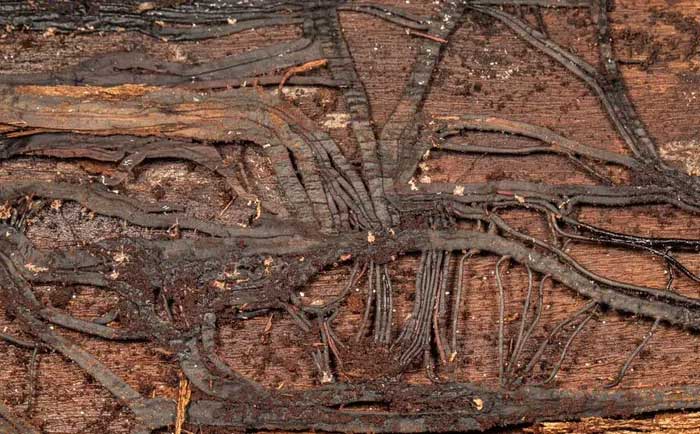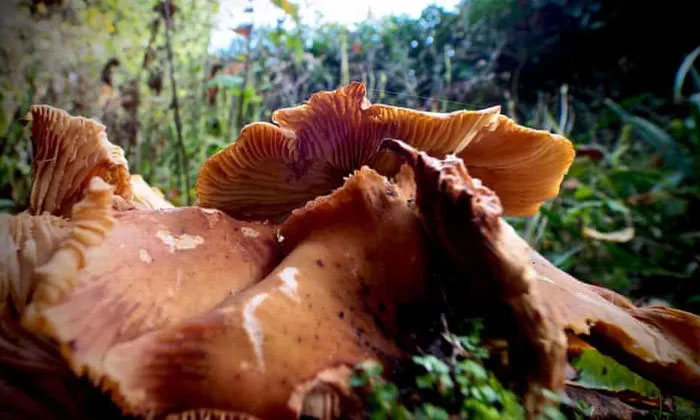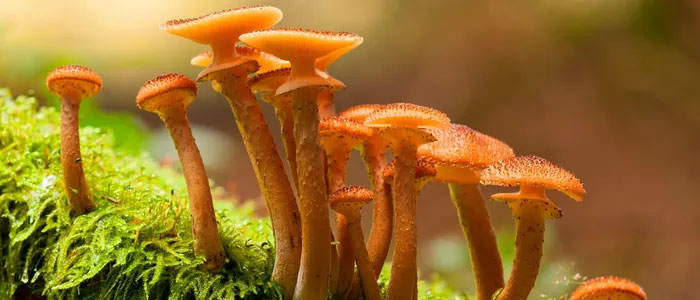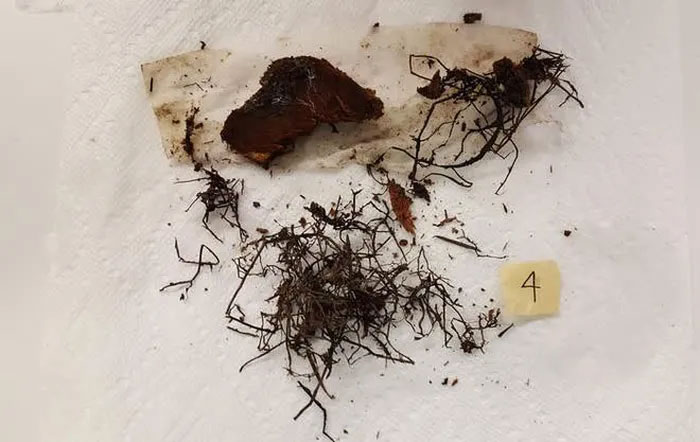They invade, penetrate, and drain the life force of their host. What are they?
The Largest Organism on Earth
Parasitic, draining the nutrients of its host until death—this is how the largest organism on the planet, weighing up to 35,000 tons, reproduces and grows.
It is not the blue whale, nor is it a long-extinct dinosaur—the largest organism in the world is a fungus known as Armillaria.
With a sprawling network of roots stretching for meters like tentacles, the Armillaria fungus parasitizes trees, consuming woody plants until they die.

“Tentacles” of Armillaria fungus clinging to a tree trunk, killing the host.
In the Malheur National Forest of Oregon, USA, a species of Armillaria ostoyae has been confirmed as the largest living organism in the world—it has grown to an astonishing size: This fungal colony spans an area of up to 9.5 square kilometers, weighing between 7,500 and 35,000 tons, and it is estimated to be 8,500 years old!
The second largest organism in the world also belongs to the Armillaria species. Specifically, the Armillaria gallica found in Michigan, USA, which researchers stumbled upon in the 1980s—it weighs four times more and is twice as large as previously thought. The Armillaria gallica in Michigan weighs 400 tons and has lived for 2,500 years!
Scientists refer to them as “real monsters” as they drain the life from hundreds of species of woody plants, decimating vegetation just like vampires consume trees!

Armillaria mushrooms emerging from the ground to release their spores. (Photo: Maria Nunzia / The Guardian)
For centuries, Armillaria (also known as honey fungus) has spread through the soil among the trees it has killed via long root networks. These strands resemble fiber optic cables attached to tree roots, producing toxins and mechanical pressure that penetrate the host’s cell walls, inundating them with white, thread-like fungal strands.
Expert László Nagy from the University of Sopron and the Hungarian Academy of Sciences exclaimed: “The rise of Armillaria has come at the cost of trees. Because of Armillaria, entire hills have been wiped out, entire forests have been decimated. If you happen to see a patch of white silver forest from above, it’s because this ‘monster’ has drained the life from those trees!”
According to scientists’ estimates, Armillaria causes millions of dollars in damage to farmers in the Americas—where there are forests that they infest. From 2000 to 2002, this fungus alone caused $1.5 million in damage to peach trees in Georgia, USA.
Trees Infected with Fungi—Only Removable
Armillaria primarily appears in the forests and vegetation of the Americas. Due to its preference for wet and cool conditions, it can be found worldwide, from warmer tropical regions to the colder temperate areas in the north.
Armillaria causes a disease known as Armillaria root rot. This disease is also commonly referred to as fungal root rot, crown rot, and honey fungus rot. It weakens the root systems of many woody plants and shrubs.
Armillaria has a long list of hosts it can infect, including many hardwood and coniferous trees.
Species in this genus are grouped into two categories: those that cause primary diseases capable of attacking and killing healthy trees, and those that cause opportunistic diseases that only kill unhealthy or wilted trees.

Looking at them, no one would think they are the largest organism in the world, capable of draining the life force from trees like a vampire. (Photo: J. FIEBER / IMAGEBROKER)
The most common Armillaria species found in Florida (USA) are Armillaria tabescens and Armillaria mellea, which belong to the opportunistic pathogen group, often attacking wilted, poorly growing trees.
Symptoms of Armillaria root rot include wilting, sparse foliage, overall decline, branch dieback, branch or trunk breakage, wilting, stunted growth, white leaves/trunks, and death.
In storms, trees infected by Armillaria can topple due to weakened trunks or decayed root systems.
The only real sign (where you can see the actual organism) of Armillaria root rot is the presence of mushrooms.
Armillaria mushrooms are clusters that range in color from light yellow to honey brown. They can be found at the base of infected tree trunks, on dead stumps, or growing away from the trunk from infected roots.
Once a tree or shrub is infected with Armillaria, it is best to remove them as quickly as possible. Stumps should also be completely removed to prevent them from becoming a food source for the fungus. There is no fungicide that can be used against Armillaria to save a tree once it is infected.
Research indicates that typical fungicides are highly toxic (containing 90% sulfur) and may not even kill Armillaria but instead stimulate its growth.
Finding the Weakness of the “Monster” Fungus
Hope for eradicating this fungus has emerged from the latest research by a team of researchers led by mechanical engineering technician Steven Naleway from the University of Utah. They discovered that the root structure of this fungus has an outer layer of melanin that protects the strands from chemicals and mechanical forces.

Armillaria ostoyae is a parasitic fungus with long black tentacles that spread out and attack vegetation. Its cord-like structure is known as a rhizomorph, which seeks out and attacks trees by sucking their nutrients. It is known to have infected and killed over 600 types of woody plants, posing a significant threat to forests and agriculture. (Photo: Debora Lyn Porter / University of Utah)
This melanin layer acts like a tough resin (and for the natural world, that resin is quite strong). This special melanin layer provides the fungus’s tentacles with the strength to create enough pressure, along with the help of enzymes, to penetrate hard woody roots and drain the nutrients from the tree.
Steven Naleway hopes that farmers, forestry officials, and pest control developers equipped with this new knowledge can devise more effective methods to combat this highly resilient and formidable fungus.


















































